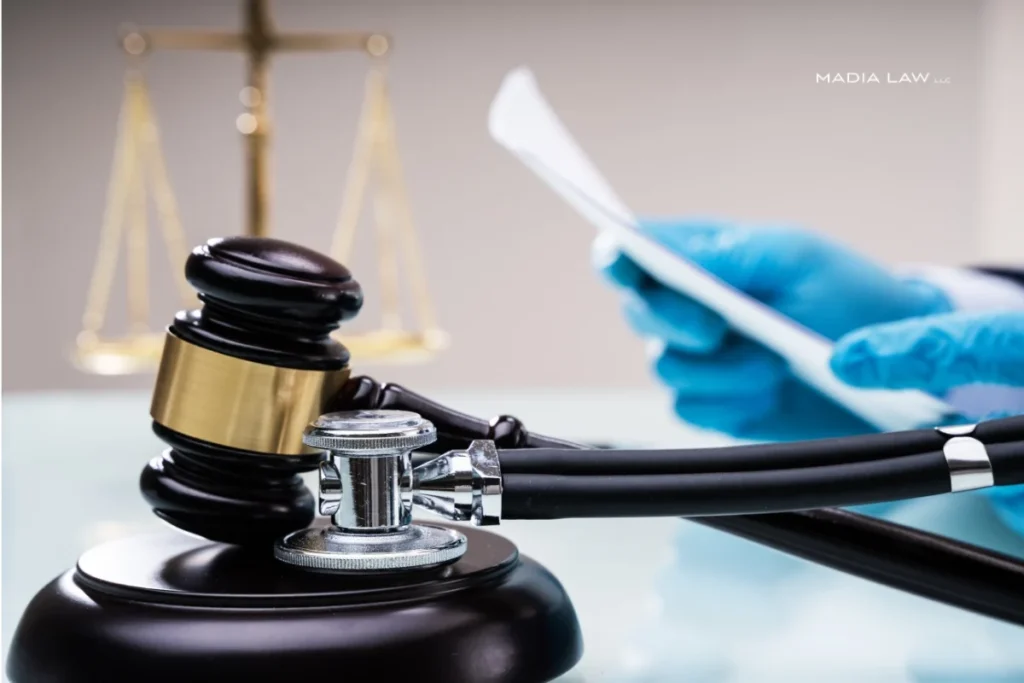
When medical care goes wrong, the impact can be overwhelming—physically, emotionally, and financially. But you are not without options. Across Minnesota, patients have turned to malpractice lawyers to seek clarity, accountability, and justice.
So, what exactly does a malpractice lawyer do? They investigate your case, gather medical records and expert testimony, and build a strong legal strategy to hold negligent providers accountable. Their role is to protect your rights while you focus on what matters most: your recovery.
At Madia Law LLC, we bring experience, dedication, and a proven track record to every case. Our team knows how the system works—and how to fight for the compensation and answers you deserve. Start with a confidential consultation and take the first step toward protecting your future.
What to Expect When You Hire a Medical Malpractice Lawyer
Hiring a medical malpractice lawyer in Minnesota means gaining a strategic advocate who takes on multiple roles to protect your interests. From building strong evidence to challenging hospitals and insurers in court, every step is designed to strengthen your case.
Case Evaluation & Determining Malpractice Viability
A medical malpractice lawyer begins by carefully evaluating whether your situation meets Minnesota’s legal definition of malpractice. This early screening focuses on key factors:
Key criteria used to evaluate a case include:
- Breach of standard of care: Did the provider act outside accepted medical practices?
- Causation: Did that deviation directly cause your injury?
- Documented harm: Is there clear evidence of physical, emotional, or financial damage?
- Economic loss: Are there measurable damages, such as medical expenses or lost wages?
- Statute of limitations: Is your claim still within Minnesota’s legal filing deadline?
Securing Critical Medical Records & Evidence
In malpractice cases, preserved evidence is the foundation for proving liability and damages. Your lawyer takes proactive steps to protect and gather key documentation, including:
- Requesting complete medical records from every facility involved in your care.
- Obtaining EMR audit trails to show who accessed or altered your records.
- Issuing preservation letters to stop hospitals from deleting or altering documentation.
- Managing HIPAA compliance and deadlines to ensure timely, lawful access.
Consulting Expert Medical Witnesses
Expert medical witnesses are crucial in establishing the standard of care and determining whether it was breached.
- Expert vetting: Lawyers choose board-certified professionals in the same specialty as the defendant.
- Court preparation: Experts are briefed on case facts and prepared for deposition or trial.
- Connecting facts to law: Their testimony links the provider’s actions to recognized standards of malpractice.
Filing Legal Documents
Medical malpractice cases involve strict procedures and deadlines. Your lawyer ensures every filing is accurate, timely, and strategically crafted, including:
- Drafting complaints and petitions that clearly outline the malpractice claims.
- Submitting court motions and responses to protect your rights during litigation.
- Tracking statutes of limitations and procedural deadlines under Minnesota law.
- Maintaining compliance with all court and evidentiary requirements.
Meeting Minnesota’s Strict Filing Deadlines
Minnesota law sets firm timelines for bringing a malpractice lawsuit, and missing them can permanently bar your claim. Your lawyer ensures full compliance with:
- General statute of limitations: Most malpractice claims must be filed within 4 years of the alleged negligence.
- Exception for minors: Patients under 18 may file until age 20.
- Affidavit of merit: An expert’s sworn statement must be filed within 180 days of starting the case.
- Pre-suit requirements: Certain claims may require advance notice before a formal lawsuit.
Negotiating With Insurance Companies
Malpractice lawyers use specialized tactics to negotiate fair settlements and reject lowball offers from insurers.
| Negotiation Tactic | Purpose and Legal Use |
|---|---|
| Demand letters | Formally request compensation based on case value and evidence. |
| Expert leverage | Use expert opinions to validate claims and increase payout pressure. |
| Valuation rebuttals | Dispute insurance valuations with proof of actual financial and non-economic damages. |
| Bad faith notice | Warn insurers if delays or denials violate Minnesota’s fair claims handling laws. |
Representing You in Court if Needed
If settlement fails, malpractice lawyers represent and guide you through every stage of trial preparation and courtroom litigation.
Typical trial phases include:
- Jury selection to ensure impartial case review.
- Direct and cross-examination of all key witnesses.
- Presentation of expert testimony to establish negligence and harm.
- Closing arguments that summarize evidence and seek a verdict.
For a legal consultation, call 612-349-2729
Legal Strategies Used to Prove Medical Malpractice in Minnesota Courts
Winning a medical malpractice lawsuit in Minnesota requires more than showing a mistake occurred; it demands clear legal strategies supported by expert guidance, admissible evidence, and courtroom precision. Each case must be built around the unique facts involved, including the type of error, the available documentation, and the arguments likely to be raised in defense of the case.
Establishing Duty and Breach via Expert Testimony
To prove malpractice, lawyers must show that a provider failed to meet the standard of care expected in Minnesota. Expert witnesses define what a competent medical professional would have done under the same circumstances. These experts review records, provide written opinions, and testify in court.
Their analysis demonstrates how the provider’s actions, or inactions, fell short of accepted medical norms. This expert testimony forms the legal backbone for proving a breach of duty.
Proving Causation Between Negligence and Injury
Once a breach is shown, lawyers will connect that breach to the patient’s actual harm. Minnesota courts require proof that the provider’s negligence was a direct cause of injury, not just a contributing factor.
This involves presenting expert analysis showing that, more likely than not, the harm would not have occurred without the error. Defense attorneys often challenge causation and must be supported by detailed medical timelines, symptom progression, and treatment outcomes.
Challenging Common Defense Tactics
Defense lawyers usually rely on the same arguments to avoid blame, and your attorney is ready to counter them. If they claim your condition was pre-existing, your lawyer highlights evidence showing the injury was new or worsened by negligence. If they argue the outcome was simply a known risk, your lawyer shows how proper care would have prevented it.
If they suggest you didn’t follow medical instructions, your lawyer proves the error happened before your actions mattered. And if they argue there was no intent to cause harm, your lawyer reminds the court that malpractice is about breaking standards—not motives.
What Is Legally Considered Medical Malpractice in Minnesota?
Medical malpractice in Minnesota occurs when a doctor or other healthcare provider makes a mistake that a reasonably careful provider would not make, and that mistake harms the patient. To constitute malpractice, it must be demonstrated that the provider had a duty to care for the patient, failed to fulfil this duty properly, and caused actual harm or loss.
Examples include a wrong or delayed diagnosis, surgery on the wrong body part, injuries during childbirth, or giving the wrong medicine or dose. However, if a patient experiences a known risk of treatment or has a poor outcome even though the doctor followed proper medical standards, it is usually not considered malpractice.
Click to contact our personal injury lawyers today
What Evidence Is Needed in a Medical Malpractice Case?
Medical malpractice claims rely on concrete, admissible evidence that proves a provider’s negligence caused harm. To prove malpractice in your lawyers rely on key types of evidence:
- Medical records – Diagnosis timelines, prescriptions, procedures, and follow-up notes.
- Audit trails & server logs – Show who accessed, altered, or reviewed patient files.
- Expert witness opinions – Explain whether care met or fell below accepted medical standards.
- Proof of harm – Reports, imaging results, or documented symptoms linking negligence to injury.
Each type of evidence helps establish legal fault, quantify damages, and meet Minnesota’s court requirements. Without the proper documentation, even valid claims may be rejected.
Complete a Case Evaluation form now
What Compensation Can You Recover?
In Minnesota, medical malpractice compensation helps restore physical, emotional, and financial losses. It generally falls into three categories:
Economic damages
These cover the measurable financial costs of malpractice. They include past and future medical bills for surgeries, hospital stays, medications, and rehabilitation. Victims may also recover lost wages, reduced earning capacity if the injury affects future income, and expenses for therapy, in-home care, or mobility aids needed for daily living.
Non-economic damages
Beyond financial loss, malpractice can cause deep personal suffering. Victims may be compensated for
- Chronic pain
- Emotional distress
- Depression
- Anxiety
- Sleep disruption
- Loss of enjoyment in life.
Importantly, Minnesota does not place a cap on non-economic damages, meaning juries can fully consider the impact on a victim’s quality of life.
Wrongful death damages
In fatal malpractice cases, families may pursue compensation for
- Funeral and burial expenses
- The loss of companionship
- Guidance
- Emotional support
- Loss of financial contributions the deceased would have provided.
Under Minnesota law, these claims are usually brought by a surviving spouse, children, or a court-appointed trustee for the estate.
Who Can Be Held Liable in a Minnesota Medical Malpractice Case?
Medical malpractice liability in Minnesota extends beyond just physicians. State law allows patients to pursue claims against both individual providers and healthcare institutions when negligent actions cause harm.
Individual Medical Providers Who May Be Liable
- Surgeons: Liable for errors made during procedures, such as wrong-site surgery or leaving instruments inside the body.
- Nurses: Responsible for medication administration errors, failing to monitor patients, or not reporting changes in condition.
- Anesthesiologists: Can be held accountable for incorrect dosing, poor monitoring, or ignoring known allergies.
- Primary Care Physicians: May be liable for delayed diagnoses, improper referrals, or misinterpreting test results.
- Specialists: Held accountable for failure to act within the expected standards of their discipline.
All licensed providers are expected to meet the accepted standard of care in Minnesota and can be individually named in a lawsuit when their conduct causes harm.
Healthcare Institutions and Third-Party Liability
Hospitals, clinics, and other healthcare facilities can be held legally accountable in several ways:
- Institutional negligence: Liability may apply if the organization created unsafe conditions, such as understaffing or failure to follow hygiene protocols.
- Vicarious liability: Institutions may be responsible for the actions of employees who commit malpractice while performing job duties.
- Credentialing or supervision failures: Facilities can be held liable for hiring unqualified staff or failing to properly monitor provider performance.
Minnesota courts allow these claims when the institution’s policies or oversight directly contribute to the patient’s injury.
Statute of Limitations for Medical Malpractice Claims in Minnesota
One of the most important roles a malpractice lawyer plays is making sure your case is filed on time. Minnesota law sets strict deadlines, and missing them can permanently block your right to recover compensation. These timelines depend on your situation, which is why early legal guidance is critical.
General deadlines
Most malpractice claims must be filed within 4 years of when the negligence occurred or was reasonably discovered. In addition, Minnesota requires an Affidavit of Merit within 180 days of filing, signed by a qualified medical expert who supports your claim. Because gathering records and expert opinions takes time, starting early is essential.
Exceptions that may extend the deadline
Some cases allow more time. For example:
- Minors can file until age 20.
- Incapacitated victims may pause the timeline until they are able to act.
- Fraud or concealment by a provider can extend the deadline if the malpractice was intentionally hidden.
Why timing matters?
Waiting too long can mean losing key evidence like electronic records or witness testimony. Even a strong case will usually be dismissed if it misses the filing deadline. A malpractice lawyer ensures you meet every requirement and protects your right to pursue justice.
How Much Do Medical Malpractice Lawyers Cost?
In Minnesota, most malpractice lawyers work on a contingency fee basis—you only pay if they win or settle your case. This makes legal help accessible without an upfront payment.
Attorney fees
- Contingency fee (33–40%) of the total recovery, depending on case complexity.
- Retainers are rare in Minnesota malpractice cases.
Case expenses (often advanced by the lawyer and deducted from recovery)
- Expert witness fees.
- Court filing and service costs.
- Medical record retrieval.
- Deposition and transcript expenses.
In Minnesota, these costs are often deducted from the final recovery, and some lawyers advance them on behalf of the client during litigation.
How Malpractice Lawsuits Drive Accountability and Safety
Malpractice lawsuits aren’t about revenge—they’re about protecting patients and improving healthcare. By exposing serious issues like delayed diagnoses, medication mistakes, or surgical errors, these claims push hospitals and providers to raise their standards, update safety protocols, and provide better training. They also hold negligent parties financially accountable through civil lawsuits, while professional boards, hospitals, or even the state may take disciplinary action when needed. Importantly, patients are protected by laws that prevent retaliation for filing complaints, ensuring they can speak up and seek justice without fear.
What Are the First Steps After Suspecting Malpractice?
Quick, informed action protects your legal rights and preserves essential evidence if you suspect medical malpractice.
Checklist of Immediate Steps:
- Request and secure your complete medical records.
- Get a second opinion from an independent medical provider.
- Document all symptoms, appointments, and outcomes in a journal.
- Take photographs of physical injuries or visible conditions.
- Preserve any relevant prescriptions, test results, or emails.
- Do not discuss legal action with the provider or facility directly.
- Contact a qualified medical malpractice lawyer in Minnesota.
- Check if you are within the legal time limit to file a claim.
FAQs About Medical Malpractice Lawsuits in Minnesota
Can I File Against Both the Doctor and Hospital?
You can file against both the doctor and the hospital if each played a role in the harm. Minnesota law allows joint liability when both provider actions and institutional failures contributed to the malpractice.
Does Signing a Consent Form Block My Case?
No. Signing a consent form does not block a medical malpractice case. Consent is not a license for negligent care. If standard procedures were violated or risks weren’t disclosed, you may still have grounds for legal action.
How Long Does a Typical Malpractice Case Take?
A typical malpractice case in Minnesota takes 18–36 months. Timelines vary depending on the complexity of the medical evidence, the availability of experts, and court scheduling. Many cases settle before trial, but some proceed through full litigation.
What’s the Difference Between Negligence and Malpractice?
The difference between negligence and malpractice lies in context. Malpractice is a type of professional negligence by licensed providers. General negligence applies to non-medical harm, while malpractice involves violating medical standards of care.
Will My Case Go to Trial or Settle?
It depends. Many medical malpractice cases settle before trial through negotiation or mediation. However, complex cases or disputes over causation may proceed to trial. Your lawyer’s strategy and evidence strength are key factors.
Can I Still File After Several Years?
It depends. In Minnesota, most claims must be filed within four years, but exceptions apply. The discovery rule, minor age, or concealment may extend the deadline. Delayed filing risks losing your right to sue.
The Practical Impact of a Malpractice Lawyer’s Work in Minnesota
Our Madia Law LLC malpractice lawyers turn medical harm into a case that holds providers accountable. They collect records, work with expert doctors, and prove how the error caused damage. Every step builds a stronger legal claim. Their work brings injured patients closer to answers and fair compensation.
Knowing this helps patients recognize when legal assistance is necessary. Contact our lawyers to act fast when records vanish or providers deny mistakes. They recognize the distinction between bad luck and genuine negligence. In a broken system, strong legal action can create real change.
Call 612-349-2729 or complete a Case Evaluation form




